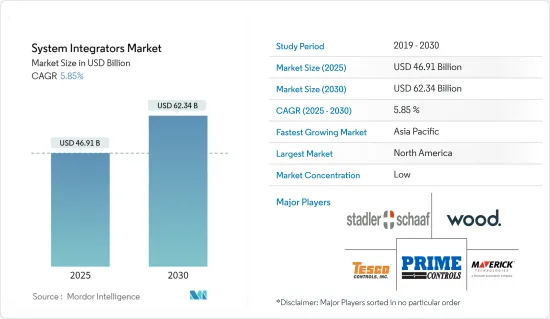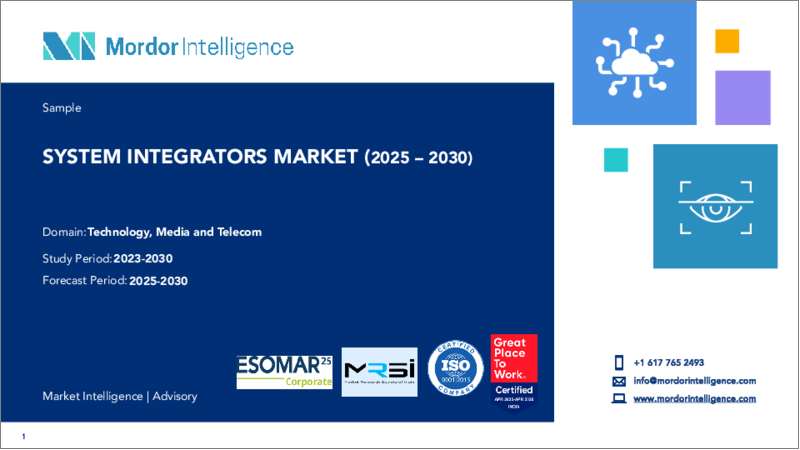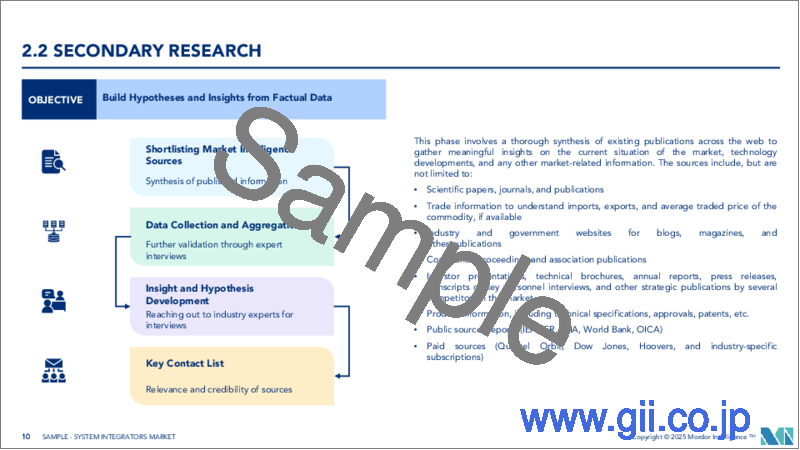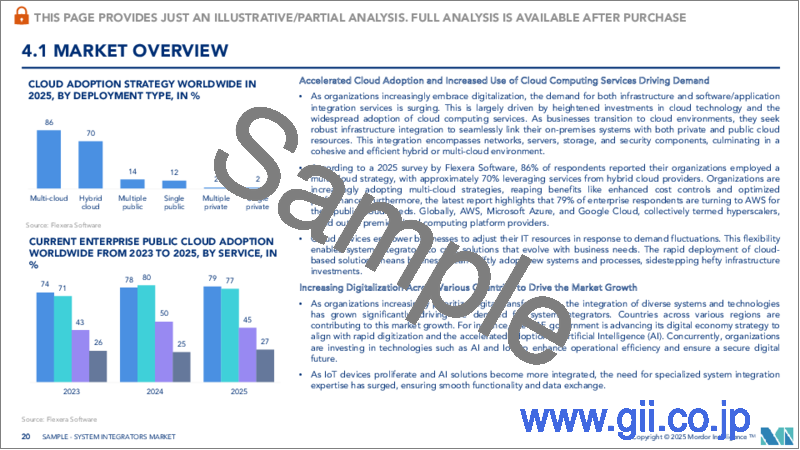|
|
市場調査レポート
商品コード
1643234
システムインテグレーター:市場シェア分析、産業動向・統計、成長予測(2025年~2030年)System Integrators - Market Share Analysis, Industry Trends & Statistics, Growth Forecasts (2025 - 2030) |
||||||
カスタマイズ可能
適宜更新あり
|
|||||||
| システムインテグレーター:市場シェア分析、産業動向・統計、成長予測(2025年~2030年) |
|
出版日: 2025年01月05日
発行: Mordor Intelligence
ページ情報: 英文 100 Pages
納期: 2~3営業日
|
全表示
- 概要
- 目次
システムインテグレーターの市場規模は、2025年に469億1,000万米ドルと推計され、2030年には623億4,000万米ドルに達すると予測され、市場推計・予測期間(2025-2030年)のCAGRは5.85%です。

システムインテグレーターは、コンポーネントのサブシステムを一つにまとめ、それらのサブシステムが共に機能するようにすることを専門としています。今日の時代、製造企業は、信頼性と品質の間の古典的なトレードオフを解消するために、フレキシブル製造システム(FMS)を導入しています。
FMSは、労働力と工程のばらつきを減らし、製品の品質を向上させるもので、さまざまな生産、マテリアルハンドリング、コンピューター制御モジュールで構成されています。このため、システムインテグレーターは、柔軟性の高い制御ソフトウエアを必要とする機械を、PLCシステムやデータベースなどのシステムと簡単に統合することができます。
主なハイライト
- 低コストでエネルギー効率の高い生産プロセスへの需要が市場を牽引しています。産業部門は、最終的なエネルギー需要と温室効果ガス排出量の点で最大の最終使用部門のひとつです。システムインテグレーターは、モーター交換やインバーター設置など、エネルギー使用量削減に直結する従来の効率改善活動に数多く携わってきました。しかし、システムインテグレーターは、オペレーション最適化を通じて、企業の環境負荷低減を支援することもできます。
- 生産工場から送られてくる情報をつなぎ、エネルギー消費情報や販売時点情報管理(POS)の詳細と掛け合わせることで、可能な最適化を特定するのに役立つレポートを提供することができます。さらに、システムインテグレーター・プログラムに参加することで、低コストの開発ツールや必要なトレーニングやサポートを期待できます。
- さらに、産業オートメーションにおけるIoT利用の拡大が市場を牽引しています。多くの企業では、IoTソリューションの利用がIT部門から運用部門に移行しており、運用部門とシステムインテグレーターの間に既存の関係があるため、システムインテグレーターはIIoTベンダーと協力しやすいです。
- 産業オートメーションにおけるモノのインターネットの利用が増加しているため、市場拡大のチャンスは多岐にわたると思われます。大半の企業だけでなく、システムインテグレーターと市場運営との間にすでに存在する関係も、オートメーション・システムインテグレーターに多くの機会を提供しています。また、柔軟な製造サプライヤーに対する市場関係者のニーズが高まっていることも、システムインテグレーター事業が今後数年間で有利に成長する可能性を高めています。
- 技術主導の現在のビジネス環境では、ビッグデータが製造業の生産性と効率性を高める主要な原動力の1つとなっています。コネクテッドデバイスやセンサーの採用率が高く、M2M通信が可能になったことで、製造業で生成されるデータポイントが大幅に増加しています。
システムインテグレーター市場の動向
産業用モノのインターネット(IIoT)の進展
- IIoTのような自動化技術を導入することで、発電所のオペレーターはリアルタイムデータを収集し、機器を遠隔監視して生産効率を向上させ、将来の問題を検出することができます。タービン、レシプロエンジン、太陽電池/パネルの効率的な運転が可能になります。配電システムは稼働時間を改善し、コストを下げ、データ収集を改善し、アラームと監視システムを改善し、自律的な問題解決を可能にします。
- IIoTは、工場、特にロボット・オートメーション・システムにおいて、より高いレベルの接続性を推進しています。この接続性により、生産性が大幅に向上し、オートメーション機器への投資収益率が高まる。
- 特に中国とインドで産業用オートメーション技術の採用が増加していることも、市場の成長に寄与しています。大手電気製品受託製造業者は、すでに業務の自動化に着手しています。また、電気自動車やハイブリッド車の需要増に対応するため、大規模なバッテリー製造施設も建設されています。産業オートメーションのニーズは、システムインテグレーター市場を強化すると予想されます。
- さらに2022年6月には、アクセラレーテッド・コンピューティング技術のリーダーであるREADY Robotics社が、ソフトウェア定義オートメーションのパイオニアであるRobotics社への戦略的投資を発表しました。何十年もの間、ロボットベンダー間のソフトウェアのサイロ化が製造業を制約してきました。ロボティクス社は、企業展開を簡素化し、オートメーション産業の市場機会を大幅に拡大する標準インターフェイスによって、その障壁を打ち破りました。
- SCADAシステムは産業プロセスの根幹であり、組織が現代の需要に対応できるよう支援しています。例えば、横河電機はSCADAアプリケーションの高性能、高可用性、広範な拡張性、およびプラットフォームの独立性を実現するために、SCADAの進化に焦点を当てています。その結果、組織は包括的で完全に統合されたSCADAアプリケーションスイートである横河のSCADAソフトウェア(Fast/Tools)、および同社のパワーと柔軟性から利益を得ています。このようなツールの採用が業界全体で増加していることが、システムインテグレーターの世界の需要を押し上げると予想されます。
- さらに、産業用IoTの採用は、基本的な機械接続から分析、自動化、エッジコンピューティングなどの高度なアプローチに進むにつれて、企業が利益を得るレベルが高まる成熟プロセスです。企業がIIoTを導入するメリットの高まりを実感するなか、テクノロジー採用企業の73%が今後12カ月で投資が増加すると見込んでおり、運輸と製造がO&Gをリードしています。ユーザーは、今後数年間の継続的な投資の結果として、自動化やリアルタイムのモニタリングといったビジネス上の優先事項の達成が増加すると予測しています。
北米が大きな市場シェアを占める
- 北米は、システムインテグレーター市場全体で大きなシェアを占めると予想されています。同地域では人的資源が不足しており、複雑なプロセスに対応する熟練した人材は高価です。その結果、企業は製造工場の自動化を進めています。
- 技術の進歩により、北米は産業オートメーション市場で高い競争力を誇っており、米国は産業オペレーションに先進技術を受け入れている先進国です。5Gワイヤレス技術の普及に伴い、産業全体のオートメーション・ソリューションの普及が進んでいます。さらに、拡張現実(AR)や仮想現実(VR)の需要が高まるにつれて、産業オートメーションとIoT市場は拡大しています。
- 2022年3月、オムロンオートメーションアメリカズは、RAMP Inc.を認定システムインテグレータープランに追加したと発表しました。RAMP社は、カスタムオートメーションやロボットシステムを開発する技術開発会社です。同社は、顧客がIIOTを利用して工場を変革し、ロボット工学を安全かつ効果的に統合することを可能にします。
- さらに、この地域ではロボット技術の利用が増加しています。汎用ロボットソリューションの世界的パイオニアであるフレクシブと、機械製造とシステム統合の大手企業であるカーディナル・マシンは、2023年5月に新たな提携を発表しました。フレクシブはカーディナルに、業界をリードする力覚とAIを活用したロボットシステムの導入に必要なツールを提供します。サンディング、研磨、パレタイジング、繊細な組み立てなど、従来は手作業が必要だった作業を完全に自動化することが可能になります。
システムインテグレーター業界の概要
システムインテグレーター市場は、国内、地域、海外に様々なプレーヤーが存在するため、断片化されています。さらに、各プレイヤーの買収が市場競争を激化させています。主要企業は、John Wood Group Plc、Tesco Controls Inc.、Prime Controls、LPです。市場競争力を維持するため、上位企業は様々な創造的商品で競争しています。多様な業界からの需要を満たすため、市場の主要企業は様々な方法を用いています。市場では、パートナーシップ、コラボレーション、買収が2つの主要な開発戦術です。
- 2023年6月-eコマース向け機械学習対応ロボットのパイオニアであるOSARO SightWorksは、フルフィルメント業務に独自のソリューションを提供するシステムインテグレーターやサードパーティロジスティクス企業(3PL)が利用できるようになった。これには、ピッキング、デパレタイジング、誘導、キッティング、その他の自動化された作業が含まれます。この活動を行うことで、ソリューション・プロバイダーは、生産性を向上させる新しい機能を顧客のシステムに与えることができます。さらに、爆発的に成長するeコマース分野でのOSAROのリーチを大幅に拡大します。
- 2022年1月-Proud Automation社が北米のMobile Industrial Robots(MiR)認定システムインテグレーターに追加されました。RGグループの子会社であるプラウドオートメーションは、北米を代表する自律移動型ロボットメーカー、モバイル産業用ロボット(MiR)の認定システムインテグレーターに認定されました。さらに、MiR AMRの導入は驚異的なスピードで加速しており、各社は顧客の要求に応える態勢を整えています。
その他の特典
- エクセル形式の市場予測(ME)シート
- 3ヶ月間のアナリストサポート
目次
第1章 イントロダクション
- 調査の前提条件と市場定義
- 調査範囲
第2章 調査手法
第3章 エグゼクティブサマリー
第4章 市場洞察
第5章 市場力学
- 市場概要
- 業界の魅力度-ポーターのファイブフォース分析
- 新規参入業者の脅威
- 買い手/消費者の交渉力
- 供給企業の交渉力
- 代替品の脅威
- 競争企業間の敵対関係の強さ
- 促進要因
- デジタルトランスフォーメーションとインダストリー4.0への取り組み
- 抑制要因
- 自動化の導入とメンテナンスのための高額投資の必要性
- COVID-19が市場に与える影響の評価
第6章 市場セグメンテーション
- エンドユーザー産業別
- 石油・ガス
- 自動車
- 航空宇宙・防衛
- ヘルスケア
- エネルギー・電力
- 化学・石油化学
- その他
- 地域別
- 北米
- 欧州
- アジア
- オーストラリア・ニュージーランド
- ラテンアメリカ
- 中東・アフリカ
第7章 競合情勢
- 企業プロファイル
- John Wood Group
- TESCO CONTROLS, INC.
- STADLER+SCHAAF
- Prime Controls, LP
- MAVERICK Technologies, LLC
- Adsyst Automation Ltd.
- George T. Hall Company
- Avanceon Ltd.
- Wunderlich-Malec Engineering, Inc.
- Burrow Global, LLC
第8章 投資分析
第9章 市場の将来
The System Integrators Market size is estimated at USD 46.91 billion in 2025, and is expected to reach USD 62.34 billion by 2030, at a CAGR of 5.85% during the forecast period (2025-2030).

System Integrators specialize in conducting component subsystems together into a whole and ensuring that those subsystems function together. In today's era, manufacturing companies are introducing Flexible Manufacturing Systems (FMS) to break the classic trade-off between dependability and quality.
FMS reduces labor and process variability, improving the quality of the product, and consists of various production, material handling, and computer control modules. This further demands system integrators where the requirement of highly flexible control software makes it simple to integrate the machines with a system such as the PLC system and database.
Key Highlights
- The demand for low-cost and energy-efficient production processes drives the market. The industry sector is one of the largest end-use sectors in terms of final energy demand and greenhouse gas emissions. System integrators have been involved in many traditional efficiency improvement activities like a motor replacement, inverters installation, etc., which are strictly related to energy usage reduction. But system integrators can also help a company reduce its environmental impact through operations optimization.
- Connecting the information coming from the production plant and then crossing them with energy consumption information and point-of-sale (POS) details can provide reports that can help identify possible optimizations, whereas having all the information separate could not have been enlightening. Further, one can expect low-cost development tools and the necessary training and support by participating in the system integrator program.
- Further, the growing use of IoT in industrial automation drives the market. The automation systems integrators are equipped with opportunity because, in most businesses, the usage of IoT solutions is shifted from being handled by the IT department to operations, and due to an existing relationship between operations and system integrators, it will, therefore, be easy for systems integrators to cooperate with IIoT vendors.
- Due to the increasing use of the Internet of Things in industrial automation, there will be a wide range of opportunities for market expansion. The vast majority of businesses as well as the already-existing relationship between system integrators and market operations offer automation systems integrators a plethora of opportunity. The market players' growing need for flexible manufacturing suppliers also increases the likelihood that the system integrator business will grow favorably over the next years.
- In the current business environment, which is technology-driven, Big Data stands as one of the primary drivers of manufacturers' productivity and efficiency. With the high rate of adoption of connected devices and sensors and the enabling of M2M communication, there has been a massive increase in the data points generated in the manufacturing industry.
System Integrators Market Trends
Advancement of the Industrial Internet of Things (IIoT)
- Implementing automation technologies such as IIoT enables power plant operators to collect real-time data and remotely monitor equipment to improve production efficiency and detect future problems. Running turbines, reciprocating engines, and solar cells/panels efficiently are possible. Power distribution systems improve uptime, lower costs, improve data collection, improve alarm and monitoring systems, and enable autonomous problem resolution.
- The IIoT is driving higher levels of connectivity in factories, especially in robotic automation systems. This connectivity enables significant productivity improvements and enhances return on investment in automation equipment.
- The increased adoption of industrial automation technologies, particularly in China and India, has also contributed to market growth. Major electrical product contract manufacturers have already begun to automate their operations. Massive battery manufacturing facilities are also being built to meet the growing demand for electric and hybrid vehicles. The need for industrial automation is expected to bolster the system integrator market.
- Furthermore, in June 2022, READY Robotics, the leader in accelerated computing technology, announced a strategic investment in Robotics, the pioneers in software-defined automation. For decades, software silos between robot vendors have constrained manufacturing. It has broken down those barriers with a standard interface that simplifies enterprise deployment and significantly expands the market opportunity for the automation industry.
- SCADA systems are at the root of industrial processes, assisting organizations in meeting modern demands. Yokogawa, for example, focuses on SCADA evolution to deliver high performance, high availability, broad scalability, and platform independence in their SCADA applications. As a result, organizations benefit from Yokogawa's SCADA software (Fast/Tools), a comprehensive, fully-integrated SCADA application suite, and the company's power and flexibility. Increasing adoption of such tools across industries is anticipated to boost the global demand for system integrators.
- Further, the adoption of industrial IoT is a maturation process in which businesses gain increasing levels of benefit as they progress from basic machine connectivity to advanced approaches such as analytics, automation, and edge computing. As organizations realize the growing benefits of implementing IIoT, 73% of technology adoption expect their investment to increase in the next 12 months, with transportation and manufacturing leading O&G. Users anticipate increased achievement of business priorities such as automation and real-time monitoring as a result of this ongoing investment over the coming years.
North America to Hold a Significant Market Share
- North America is anticipated to hold a significant share of the overall system integrator market. Human resources are scarce in the region, and skilled resources for complex processes are expensive. As a result, companies have increased automation in their manufacturing plants.
- Due to technological advancements, North America has been highly competitive in the industrial automation market, with the United States being a developed country that accepts advanced technologies for industrial operations. Automation solutions across industries are becoming more prevalent as 5G wireless technology becomes more widely available. Furthermore, as demand for augmented reality (AR) and virtual reality (VR) grows, the industrial automation and IoT markets are expanding.
- In March 2022, Omron Automation Americas announced that it had added RAMP Inc. to its Certified System Integrator plan. RAMP is a technology development firm that creates custom automation and robotic systems. It enables customers to use IIOT to transform their factories and integrate robotics safely and effectively.
- Additionally, the region is witnessing a rise in the use of robotic technologies. For Flexiv, a global pioneer in general-purpose robotics solutions, and Cardinal Machine, a major player in machine building and systems integration, announced their new collaboration in May 2023. Flexiv will give Cardinal the tools necessary to implement robotic systems that make use of industry-leading force sensitivity and AI. It will be possible to fully automate operations like sanding, polishing, palletizing, and delicate assembling that would traditionally need manual labor.
System Integrators Industry Overview
The system integrator market is fragmented as various local, regional, and international players exist. Further, the players' acquisition is setting high market competitiveness. The key players are John Wood Group Plc, Tesco Controls Inc., Prime Controls, and LP. o stay competitive in the market, the top firms compete with a variety of creative goods. To meet demand originating from diverse industries, the market's top players are using a variety of methods. In the market, partnerships, collaborations, and acquisitions are the two main development tactics.
- June 2023 - OSARO SightWorks, a pioneer in machine learning-enabled robotics for e-commerce, is now accessible to system integrators and third-party logistics companies (3PLs) that provide distinctive solutions for fulfillment operations. This includes picking, depalletizing, induction, kitting, and other automated jobs. By taking this activity, solution providers can give clients' systems new capabilities that increase productivity. Additionally, it significantly expands OSARO's reach in the explosively growing e-commerce sector.
- January 2022 - Proud Automation has been added to North America's Mobile Industrial Robots (MiR) certified system integrators. Proud Automation, an RG Group subsidiary, has been named a Certified Systems Integrator by North America's leading manufacturer of autonomous mobile robots and Mobile Industrial Robots (MiR). Furthermore, the adoption of MiR AMRs is accelerating at an incredible rate, and companies are poised to meet customers' demands.
Additional Benefits:
- The market estimate (ME) sheet in Excel format
- 3 months of analyst support
TABLE OF CONTENTS
1 INTRODUCTION
- 1.1 Study Assumptions and Market Definition
- 1.2 Scope of the Study
2 RESEARCH METHODOLOGY
3 EXECUTIVE SUMMARY
4 MARKET INSIGHTS
5 MARKET DYNAMICS
- 5.1 Market Overview
- 5.2 Industry Attractiveness - Porter's Five Forces Analysis
- 5.2.1 Threat of New Entrants
- 5.2.2 Bargaining Power of Buyers/Consumers
- 5.2.3 Bargaining Power of Suppliers
- 5.2.4 Threat of Substitute Products
- 5.2.5 Intensity of Competitive Rivalry
- 5.3 Drivers
- 5.3.1 Digital Transformation and Industry 4.0 initiatives
- 5.4 Restraints
- 5.4.1 Requirement of High Investments for Automation Implementation and Maintenance
- 5.5 Assessment of the COVID-19 Impact on the Market
6 MARKET SEGMENTATION
- 6.1 By End-user Industry
- 6.1.1 Oil and Gas
- 6.1.2 Automotive
- 6.1.3 Aerospace and Defense
- 6.1.4 Healthcare
- 6.1.5 Energy & Power
- 6.1.6 Chemical and Petrochemical
- 6.1.7 Others
- 6.2 By Geography
- 6.2.1 North America
- 6.2.2 Europe
- 6.2.3 Asia
- 6.2.4 Australia and New Zealand
- 6.2.5 Latin America
- 6.2.6 Middle East and Africa
7 Competitive Landscape
- 7.1 Company Profiles
- 7.1.1 John Wood Group
- 7.1.2 TESCO CONTROLS, INC.
- 7.1.3 STADLER + SCHAAF
- 7.1.4 Prime Controls, LP
- 7.1.5 MAVERICK Technologies, LLC
- 7.1.6 Adsyst Automation Ltd.
- 7.1.7 George T. Hall Company
- 7.1.8 Avanceon Ltd.
- 7.1.9 Wunderlich-Malec Engineering, Inc.
- 7.1.10 Burrow Global, LLC





